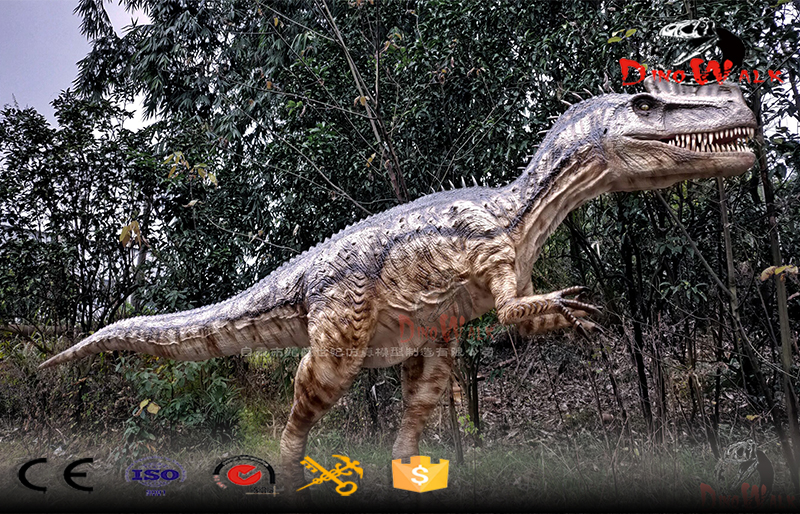Interesting Restoration of Dinosaur Fossils
When restoring ancient creatures, we have long relied on the excavated fossils. However, the lack of fossils or the inference of their living habits based on fossils not only produces errors, but sometimes the research results announced are quite different. Animatronic Dinosaur is made on the basis of research.
An example of the Cretaceous large carnivorous dinosaur "Spinosaurus": A new study announced that new spinosaurus fossils show that they are not walking on strong legs, but have a pair of "small short legs", most of the time swim in the water!
Animatronic Dinosaur
The new fossils include not only the iconic spinosaur's iconic long mouth, big back sails, but also the hind limbs that appeared for the first time. You have to know that humans have discovered Spinosaurus for more than 110 years and have not found their complete limb bones. The restoration of their postures is mainly based on other carnivorous dinosaurs, so it is generally believed that they also have a strong pair of hind legs. However, according to the new fossil, Spinosaurus' hind limbs are only half as long as previously thought, and they can only walk on their bodies! The newly restored Spinosaurus was unable to stand up and was only over 2 meters high, even with a backsail of 4 meters. Spinosaurus "transformed" not only changed its appearance, but also provided more basis for their semi-aquatic habits.
In recent years, paleontologists have found many semi-aquatic features from Spinosaurus fossils, such as pressure-sensing holes in the skull, high-density bones suitable for diving, and oxygen isotope content in fossils similar to aquatic animals ... and this time It was found that it is possible to prove that the entire body structure of Spinosaurus is more suitable for swimming than walking. With a body over 15 meters long and sharp claws, a spinosaurus swimming in the water was undoubtedly the "king of freshwater" at that time. It is almost impossible to save all the skeletons of large dinosaurs. It is usually "complete fossils" to find 30%, and the rest is left to the brains of the researchers themselves. A few new fossils have changed the image of Spinosaurus, does it mean that paleontology is not reliable? After all, after the death of ancient creatures hundreds of millions of years ago, there is only a very small chance that the remains can become fossils. Fossils in the hands of paleontologists are often only a small part of the animal's body. Using this thing to speculate, it is simply "blind man touching the elephant"
The first human dinosaur to recover is Iguanodon. This classic story can show the difficulty and fun of recovery. In the mid-19th century, the top scholars of the British Empire accurately judged that they belonged to reptiles based on a small amount of fossils such as teeth, but what they could recover was a bloated and heavy "four different"! Because at the time, they did not know the body structure of other dinosaurs, and could only refer to the appearance of modern animals such as rhinos, hippos, crocodiles, and iguanas. Later, as more and more dinosaur fossils were unearthed, paleontologists became more and more confident.
1. The restoration of Iguanodon in the mid-19th century resembled a mixture of iguanas and rhinoceros, with a "sharp horn" on the nose, representing the people's imagination of "prehistoric reptiles" at that time.
2. In the early 20th century, more fossils showed that Iguanodon had a hind limb far more developed than its forelimb, so it recovered to an upright posture similar to a kangaroo. The "sharp angle" on the nose was also proved to be a sharp, thorny thumb used as a self-defense weapon.
3. The current image of Iguanodon: It usually uses four legs to walk, but only two legs when running. Its tail will not drag on the ground like a lizard, and its posture is lighter than before.
The early recovery of Iguanodon was "silly and stupid", not only because there were too few reference materials, but also from the people's contempt for reptiles at that time-dinosaurs were large lizards, then they should be as cold-blooded, dull as reptiles, and stay dirty In the swamp. It was later discovered that Iguanodon's hind limbs were much more developed than its forelimbs, so the recovered Iguanodon again imitated kangaroos, posing in a stiff, upright posture. It wasn't until the late 20th century that dinosaurs and birds were closer to each other that Iguanodon was restored to a light and sensitive look, and the image of small dinosaurs in feathers was gradually accepted.
The above is an interesting restoration of dinosaur fossils introduced by Museum Dinosaur Manufacturer.




